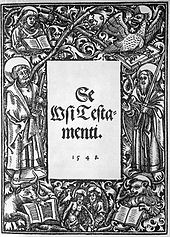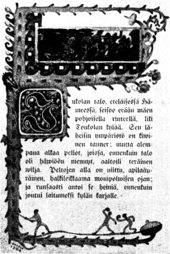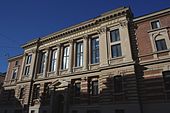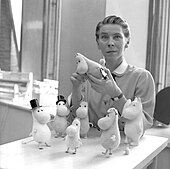Finnish literature
Under Finnish literature in which is below the Finnish language written literature understood. For Swedish- language literature created in Finland and for other languages, see the section Foreign-language literature from Finland . Finnish literature is part of Scandinavian literature .
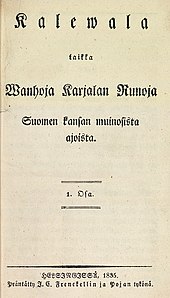

Finnish-language literature
Finnish literature takes account of the vicissitudes of the country's history, because for long periods the governmental and cultural language was different from the Finnish vernacular . Finland was an integral part of Sweden for almost seven hundred years (see the Part of Sweden section in the History of Finland article ). In the more than 100 years that followed, when Finland was a Grand Duchy within the Russian Empire with extensive internal autonomy (see Grand Duchy of Finland ), Swedish initially remained the dominant language. Finnish did not become an official language with equal status until 1902 (see Finnish language policy ). When Finland joined the EU in 1995, Finnish became one of the official languages of the European Union .
Underlying the greatest works of Finnish-language literature is the intent to create and maintain a strong Finnish identity .
Before the 16th century
What was written in the Finnish language is relatively new, so no significant literature has survived from the Middle Ages or before. Some important books, such as the Bible or written laws, were only available in Latin , Swedish, or other European languages ( French or German ) until the 16th century .
Probably the oldest Finnish text is a translation of the prayer Our Father in the book Cosmographia (in German-Latin version) published by Sebastian Münster in Basel in 1544 .
Creation of a literary language in the 16th century
The written Finnish language was finally founded by the Lutheran pastor Mikael Agricola (1510–1557), who relied on Western dialects. His main work is the New Testament ( Se Wsi Testamenti ) in Finnish translation , published in 1548 and the first work written in Finnish literary language.
Kalevala - national epic

Kalevala
The Finnish epic Kalevala is a collection of Finnish folk poetry that Elias Lönnrot (1802-1884) has collected over decades from orally transmitted chants and is poetically linked to form a unified whole. It was first published in 1835. The work quickly became the Finnish national epic and a symbol of Finnish nationalism . Anton Schiefner (1817–1879) created the first translation into German (1852) under the title Kalewala, the national epic of the Finns , the current German translation was by Hans Fromm (1967).
Kanteletar
Kanteletar, a collection of Finnish folk poetry compiled in 1840 by Elias Lönnrot, is considered a lyrical “sister work” of the Kalevala .
The works had a great influence on other Finnish artists, such as Jean Sibelius (1865–1957), the internationally most acclaimed Finnish composer.
The seven brothers
The first novel published in Finnish , which is also considered to be one of the greatest works, if not the greatest work in Finnish literature, is The Seven Brothers (1870) by Aleksis Kivi (1834–1872). Another classic text from his pen is the peasant comedy Die Heideschuster (1864).
20th century
Frans Eemil Sillanpää (1888–1964) was the only Finn to receive the Nobel Prize for Literature in 1939 for his novel Nuorena nukkunut (1931, German: Silja, die Maid ) . The novel is about the early tuberculosis death of the beautiful country girl Silja; it was newly translated into German in 2017 (“young sleep”). In the 1930s, an autobiographical worker's literature emerged in Finland, the first and most important representative of which was Toivo Pekkanen ( Tehtan Varjossa , 1932). The chronologically preceding novel Lapsuuteni ("Meine Kindheit", Leipzig 1987), which appeared only in 1953, was translated into German.
After the Second World War
After the Second World War , Väinö Linna (1920–1992) , committed to social realism, published his best-known work The Unknown Soldier or Crosses in Karelia (Finnish original title: Tuntematon sotilas ). In the work published in 1954, he describes the war against the Soviet Union and criticizes the heroic pathos. It was only published in full in 2000 because many passages were considered offensive in the post-war period. His trilogy Here Under the Polar Star describes the wounds of the civil war after the First World War.
The extensive historical novel Sinuhe (1945) by the writer Mika Waltari (1908–1979), who also published detective novels and short stories, became popular worldwide .
Contemporary literature
Arto Paasilinna (* 1942) achieved international success through humorous novels with titles such as The Wonderful Mass Suicide , Board Meeting in Paradise , World Rescue for Beginners . Annika Idström (1946–2011) was also known in Germany for her novels. Tommi Kinnunen (* 1973) wrote family novels with autobiographical echoes. In the novel Kärjäläinen ja jänis ( beggar and rabbit ) by Tuomas Kyrö (* 1974) a Romanian beggar struggles through the whole country. Several of Antti Tuomainen's novels and thrillers have been translated into German (“Klein-Sibirien” 1920).
The epic of history has recently been gaining importance again. The novel “Purgatory” by the Finnish-Estonian author Sofi Oksanen (* 1977) has been translated into almost 40 languages. It is about the horrors of National Socialism and Stalinism in Finland and Estonia . Jari Järvelä (* 1985) and Jari Tervo (* 1959), who was also honored as the author of a detective novel, wrote historical trilogies of novels on the turning points in recent Finnish history. Katja Kettu (*! 978) became known in Germany through the novel Kätilö (2011; Eng. "Wildauge", 2014) about a German-Finnish love affair during the Winter War.
Mediators of Finnish culture and literature in the German-speaking area are Hans Fromm (translation of the Kalevala ) and, in the younger generation, Stefan Moster , the works of Rosa Liksom , Hannu Raittila , Kari Hotakainen , Mikko Rimminen , Markku Ropponen, Petri Tamminen and many other Finnish authors translated and was awarded the Finnish State Translation Prize in 2001.
Academic institutions

Matthias Alexander Castrén (1813-1852) was appointed first professor of the newly created chair for Finnish language and literature at the University of Helsinki in 1851 .
Finnish Literary Society
The Finnish Literary Society ( Finnish: Suomalaisen Kirjallisuuden Seura or SKS) was founded in 1831 to promote literature written in Finnish . Kalevala , the Finnish national epic , was one of her first publications . She is the editor of the Finnish Literature Society Editions . She published various broad compilations, such as the 34-volume collection Suomen Kansan Vanhat Runot (The old folk poetry of Finland), the compilations Suomen Kansan Sävelmiä ( Finnish folk songs ), Kalevalan Bunojen Historia ( history of Kalevala songs ) and Suomalaisen teatterin historia ( history of the Finnish theater ).
Folk poetry archive

The results of the society's collecting work are kept and researched in the large folk poetry archive of the Finnish Literary Society.
It is the world's largest and most extensive archive of folk traditions.
Literary prizes
The Finns' enthusiasm for reading is expressed, among other things, in the fact that many literary prizes are awarded in Finland. The Finlandia Prize ( Finnish. Finlandia-palkinto , Swedish. Finlandiapriset ) is one of the most renowned literary prizes in Finland , which has been awarded annually since 1984 by the Finnish Letter Foundation (Finnish. Suomen Kirjasäätiö , Swedish. Finlands bokstiftelse ) for a work of fiction and since 1993 exclusively for a novel . The Finnish Crime Prize has been awarded since 1985, and since 1993 also in the international category .
various
Finland was the guest country of the Frankfurt Book Fair in 2014 . This year around 140 titles were translated into German.
Other language literature from Finland
Finland Swedish literature

The Finland Swedish literature is regarded as a rule, of Finnish-speaking Finns as an integral part of Finnish culture. The main work of the Swedish-speaking Finnish national romanticism was the verse epic Fähnrich Stahl (1848/60) by Johan Ludvig Runeberg , who also wrote the text of the Finnish national anthem (in Swedish).
Tove Jansson (1914–2001), the creator of the Moomins , probably Finland's most famous literary figures, is one of the most famous Finnish-Swedish writers of recent times . These are fictional hippopotamus-like troll creatures that are usually better known today as comics or in the form of caricatures.
As a younger Finnish-Swedish author, Philip Teir (* 1980) was also known for his historical novel Winter War .
- See also: Finland Swedish Modernism , Swedish Literature
Sami literature
Kirsti Paltto (* 1947) describes in her novel “ Signs of Destruction ” the losses her people suffered in the war. It was the first book to be translated from Sami into German in 1997 .
- See also: Sami (people) and Scandinavian literature (Sami literature) .
See also
- Finnish-speaking writers (list)
- List of Finnish Literature Awards (Finnish)
- Link list: Finnish literature
- Literary monuments of Finland until 1805 (Czech)
- Turku Academy
- Åbo Akademi
- Finnish-Ugric Society
- Finnish Ancient Society ( Suomen muinaismuistoyhdistys )
literature
- Jaakko Ahokas: A History of Finnish Literature . Indiana University Press, Bloomington USA, 1973, ISBN 978-0-87750-172-5
- Finland: A Cultural Encyclopedia (Finnish Literature Society Editions). 2000
- George C. Schoolfield: A History of Finland's Literature (History of Scandinavian Literatures, vol. 4) 1998 ( partial online view )
- Gisbert Jänicke (editor): Finland. - explorations. 22 narrators from Finland. Translated from the Finnish by Gisbert Jänicke, Regine Pirschel and Peter Uhlmann. Translated from the Swedish by Gisela Kosubek and Widerun Rehwaldt. With a comment by the editor, 2nd edition, Volk und Welt, Berlin (East) 1988
- Manfred Peter Hein (Hrsg.): Modern storytellers of the world: Finland. (Anthology) Erdmann, Tübingen 1974
- Erich Kunze: Finnish literature in German translation 1675–1975 . A bibliography. Painatusjaos, Helsinki 1982
- Hans Grellmann: Finnish literature . Ferdinand Hirt, Breslau 1932
- Eino Leino : The main features of Finnish literature [1918] . Klett-Cotta, Stuttgart 1980
- Horst Bien: Northern European literatures . VEB Verlag, 1980 (content: Danish, Norwegian, Finnish literature and many more)
- Johann Jakob Meyer: From the Land of a Thousand Lakes - A Treatise on Newer Finnish Literature and a Selection from Several Finnish Novellists , Georg Wigand, Leipzig 1910
- Kai Laitinen: Finland's Modern Literature . From the Finnish by C.-A. von Willebrand. - Writings from the Finland Institute in Cologne. Volume 8, Verlag Christoph von der Ropp, Hamburg 1969
- Pirkko Liisa Rausmaa: A catalog of anecdotes in the Folklore Archives of the Finnish Literature Society . Turku: Nordic Inst. Of Folklore / Helsinki: Suomalaisen Kirjallisuuden Seuran
- Emil Setälä : “The Finnish Literature”. In: The Eastern European Literatures and the Slavic Languages , ed. by Adalbert Bezzenberger u. a., Berlin and Leipzig 1908, pp. 309–332 ( digitized version )
- Kai Laitinen: Literature of Finland: In Brief . 2001
- Kai Laitinen: An overview of Finnish literature . Otava Verlag, Helsinki 1989
- Pertti Lassila: History of Finnish Literature . A. Francke Verlag, Tübingen and Basel 1996
- Pekka Tarkka: Finnish contemporary literature. Fifty author portraits . Otava Verlag, Keuruu 1983
- Runar Schildt : Zoja and other stories (Armas Fager, The Hexenwald (Häxskogen), The Weaker One (Den svagare), The Meat Grinder (Köttkvarnen)). Stories from Finland. Translated from the Finnish Swedish by Gisbert Jänicke . Selection and epilogue by Aldo Keel. Manesse , Zurich 2001, ISBN 3-7175-1972-7
Web links
- Little ABC of Finnish literature: Everything you need to know ( Stefan Moster , NZZ , October 7, 2014)
- Finnish literature in German translation ( Embassy of Finland, Berlin )
- Finnish (Ingrid Schellbach-Kopra)
- The Finns are coming , TAZ (Katharina Granzin)
- Finnish literature: a fleeting glow (DLF)
- finland.fi: Finnish contemporary literature: A wealth of voices
- Finns enthusiastic about reading (ZEIT, 2006)
References and footnotes
- ↑ See the article by Hans Fromm in the Enzyklopädie des Märchen , Volume 7, 1993 ( partial online view ).
- ↑ Kalewala, the national epic of the Finns (de.wikisource.org)
- ↑ see also Finnish music
- ↑ see under skvr.fi
- ↑ See Annette Sabban, Jan Wirre (Ed.): Proverbs and sayings in an intercultural comparison . Westdeutscher Verlag, Opladen 1991, p. 37 ( Folk poetry archive & f = false online partial view ). See also the article on the Finnish fairy tale researcher Antti Aarne (1867–1925) by Pirkko-Liisa Rausmaa ( folk poetry archive & f = false online partial view ); see. Aarne-Thompson Index
- ^ Ingrid Schellbach-Kopra: Finnish ; see. Official website ( English ( Memento des Originals from February 22, 2006 in the Internet Archive ) Info: The archive link has been inserted automatically and has not yet been checked. Please check the original and archive link according to the instructions and then remove this note. ) & Archives of the Finnish Literature Society ( page no longer available , search in web archives ) Info: The link was automatically marked as defective. Please check the link according to the instructions and then remove this notice.
- ↑ Finnish folk tales . Diederichs, Munich 1993, p. 315
- ↑ In a Runeberg project in Sweden named after the Finnish-Swedish poet Johan Ludvig Runeberg, texts with expired copyrights from the Nordic countries are digitized and freely accessible on the Internet.
- ↑ see also Winter War
- ↑ Book and author information on the website of the Persona Verlag
